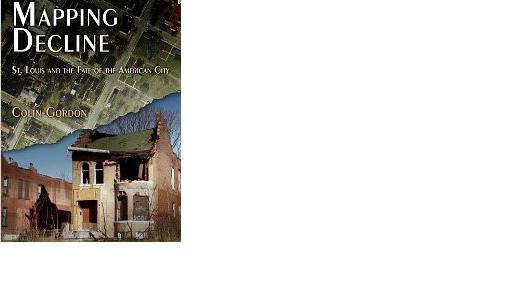 Last week, I introduced Wellston Loop readers to Colin Gordon’s detailed study, Mapping Decline: St. Louis and the Fate of the American City (Penn Press, 2008).
Last week, I introduced Wellston Loop readers to Colin Gordon’s detailed study, Mapping Decline: St. Louis and the Fate of the American City (Penn Press, 2008).
This week, I want to zero in on twin issues in the book – “urban abandonment” (nearly synonymous in St. Louis’s case with “white flight”) and the simultaneous phenomenon of suburbanization.
“By almost any objective or subjective standard,” says a 1970s New York Times report Gordon cites, “St. Louis is still the premier example of urban abandonment.”
As I noted last week – and as virtually every historian of St. Louis reports – the City of St. Louis saw dramatic losses in population throughout the twentieth century. Here’s a quick snapshot, from the highest population in 1950 to the current figure from the 2010 census:
1950: 856,796
1960: 750,026
1970: 622,236
1980: 452,801
1990: 396,685
2000: 348,189
2010: 319,000
In fact, St. Louis’s population is now equal to what it was in the 1870s!
While the City was emptying out, the surrounding County was growing – pushed forward by rapid suburbanization. Gordon describes a 1947 pamphlet that “extol[ed] the virtues of the suburbs.” The pamphlet “portrayed St. Louis County as a demographic rocket and the City as a horse and buggy” and “rated the area’s neighborhoods according to average rents, population density, and the ‘presence of negroes.’” The pamphlet’s bottom line? “People Who Can, Move Away.”
What was behind the abandonment of the city and the push out into the County? Gordon points to “the impact of federal housing policy.” “FHA mortgage insurance flowed primarily to the suburbs, subsidizing white flight,” Gordon maintains. “To the casual observer,” he says, “this was just the market at work: the dispersal of population from the old urban core to the suburban periphery is a fairly universal pattern, accelerated in the postwar American setting by a combination of available land and general prosperity.”
At the same time, “[f]ederal public housing assistance flowed primarily to the inner city,” and “residential opportunities” were “regulated, restricted, and rigged,” “crowd[ing]” mostly African American populations “into a few older neighborhoods while effectively barring their escape to the suburban fringe.” Thus, these policies “cement[ed] the region’s spatial organization of race and poverty.” (More on this move toward hypersegregation in next week’s post.)
One 1950s City official described the situation this way: “The segregated black community was left to fester, while developers aided by the federal government rushed out to build new white enclaves on the city’s edge.”
The impact was stark. Gordon writes:
Over time, the accumulation of residential choices achieved no equilibrium but only hardened patterns of residential segregation and, by robbing the central city of its tax base, encouraged even more people to escape the fiscal wreckage (baser public services, underfunded schools) left behind. Over time, the City dipped below the demographic and economic thresholds necessary to sustain even basic urban activities or expectations (public transit, downtown retail and leisure, industrial clusters.
Gordon describes the basic pattern early in Mapping Decline – and then spends the rest of the book showing exactly how the pattern played out in St. Louis. He writes:
This general condition . . . is the seemingly iron law of urban decay: Rising incomes breed suburbanization. Suburbanization robs inner cities of their tax base. Inner city concentrations of poverty widen gaps between urban residents and substantive economic opportunities, and between suburban residents and urban concerns. And all of this encourages more flight, not only from the metropolitan core, but from decaying inner suburbs as well.
Though St. Louis was to reach its high population in 1950, already the forces of urban abandonment were being felt in 1936, when the City Plan Commission concluded:
To state the condition in its simplest term, if adequate measures are not taken the city is faced with gradual economic and social collapse. The older central areas of the city are being abandoned and this insidious trend will continue until the entire city is engulfed.
Ultimately, urban decay was not to stop with the City of St. Louis’s restrictive boundary – but would go on to plague inner-ring suburbs, such as Wellston. In a later post, I’ll look at Gordon’s analysis of what happened to those inner-ring suburbs.
Next up: Gordon’s analysis of “hypersegregation” in St. Louis.